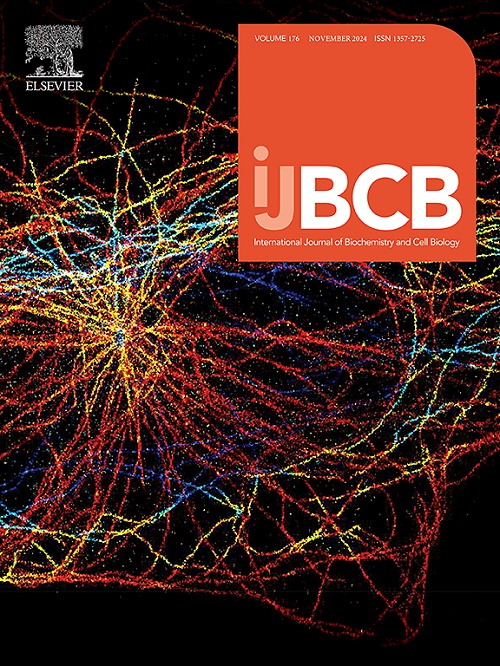高糖条件下脂肪组织巨噬细胞来源的外泌体MiR-500a-5p通过抑制Nrf2表达促进脂肪细胞炎症
IF 2.8
3区 生物学
Q2 BIOCHEMISTRY & MOLECULAR BIOLOGY
International Journal of Biochemistry & Cell Biology
Pub Date : 2024-11-29
DOI:10.1016/j.biocel.2024.106713
引用次数: 0
摘要
背景2型糖尿病(T2DM)是一种以胰岛素抵抗和慢性炎症为特征的慢性代谢紊乱。脂肪组织巨噬细胞(ATMs)是脂肪组织中介导促炎反应的核心参与者,已被证明通过外泌体分泌影响胰岛素敏感性。虽然巨噬细胞来源的外泌体miRNA在各种疾病中的作用已经被研究过,但它们在T2DM中的致病作用,特别是巨噬细胞来源的外泌体miRNA在脂肪组织炎症中的作用仍未被充分探索。目的本研究专门针对T2DM,探讨atm来源的外泌体mirna在脂肪组织炎症中的作用,这是T2DM发病的一个关键因素。方法从糖尿病患者和非糖尿病患者内脏脂肪组织中分离出satm。通过高通量RNA测序预测atm衍生外泌体中差异表达的mirna。选择RAW264.7巨噬细胞和3T3-L1前脂肪细胞作为模型系统。采用定量RT-PCR检测miR-500a-5p的表达。双荧光素酶实验证实miR-500a-5p与Nrf2 mRNA 3 ' UTR的直接结合。结果高糖处理巨噬细胞外泌体中也富集smir -500a-5p。此外,当与脂肪细胞共培养时,这些外泌体诱导miR-500a-5p的高表达和NLRP3炎性体的激活。此外,通过使用miR-500a-5p抑制剂降低巨噬细胞中miR-500a-5p的表达,改善了外泌体的促炎特性,并且将这些外泌体与脂肪细胞共培养导致脂肪细胞中NLRP3炎症小体相关蛋白的表达降低。相反,诱导miR-500a-5p表达会导致相反的结果。此外,双荧光素酶检测证实miR-500a-5p直接靶向Nrf2 mRNA的3 ' UTR。与miR-500a-5p不同,Nrf2表现出抗炎反应。结论atm来源的外泌体miR-500a-5p通过下调脂肪细胞中Nrf2,促进NLRP3炎性体活化和脂肪组织炎症。本文章由计算机程序翻译,如有差异,请以英文原文为准。
Adipose tissue macrophages-derived exosomal MiR-500a-5p under high glucose promotes adipocytes inflammation by suppressing Nrf2 expression
Background
Type 2 diabetes (T2DM) is a chronic metabolic disorder characterized by insulin resistance and chronic inflammation. Adipose tissue macrophages (ATMs), central players in mediating pro-inflammatory responses within adipose tissue, have been shown to influence insulin sensitivity through exosome secretion. While the role of macrophages-derived exosomal miRNA has been studied in various diseases, their pathogenic roles in T2DM, particularly ATMs-derived exosomal miRNA in adipose tissue inflammation, remain underexplored.
Objectives
This study focuses specifically on T2DM, investigating the role of ATM-derived exosomal miRNAs in adipose tissue inflammation, a critical factor in the pathogenesis of T2DM.
Methods
ATM were isolated from visceral adipose tissues in patients with or without diabetes. Differentially expressed miRNAs in ATM-derived exosomes were predicted by high-throughput RNA sequencing. The RAW264.7 macrophages and 3T3-L1 preadipocytes was selected as a model system. Quantitative RT-PCR was used to assess miR-500a-5p expression. The direct binding of miR-500a-5p to Nrf2 mRNA 3′ UTR was verified by dual luciferase assay.
Results
MiR-500a-5p was also enriched in the exosomes of high-glucose-treated macrophages. Furthermore, these exosomes induced high expression of miR-500a-5p and activation of the NLRP3 inflammasome in adipocytes when co-cultured with them. Additionally, the reduction of miR-500a-5p expression in macrophages by using a miR-500a-5p inhibitor ameliorated the pro-inflammatory properties of the exosomes, and co-culturing these exosomes with adipocytes resulted in decreased expression of NLRP3 inflammasome-associated proteins in adipocytes. In contrast, induction of miR-500a-5p expression led to the opposite results. Moreover, the dual-luciferase assay confirmed that miR-500a-5p directly targeted the 3′ UTR of Nrf2 mRNA. Unlike miR-500a-5p, Nrf2 exhibited an anti-inflammatory response.
Conclusion
The results indicate that ATM-derived exosomal miR-500a-5p promotes NLRP3 inflammasome activation and adipose tissue inflammation through down-regulation of Nrf2 in adipocytes.
求助全文
通过发布文献求助,成功后即可免费获取论文全文。
去求助
来源期刊
CiteScore
8.10
自引率
0.00%
发文量
124
审稿时长
19 days
期刊介绍:
IJBCB publishes original research articles, invited reviews and in-focus articles in all areas of cell and molecular biology and biomedical research.
Topics of interest include, but are not limited to:
-Mechanistic studies of cells, cell organelles, sub-cellular molecular pathways and metabolism
-Novel insights into disease pathogenesis
-Nanotechnology with implication to biological and medical processes
-Genomics and bioinformatics

 求助内容:
求助内容: 应助结果提醒方式:
应助结果提醒方式:


